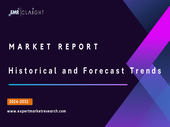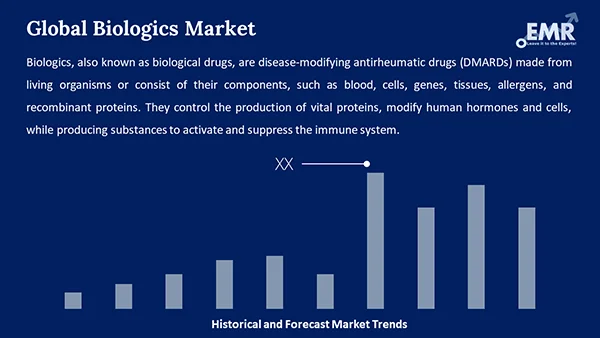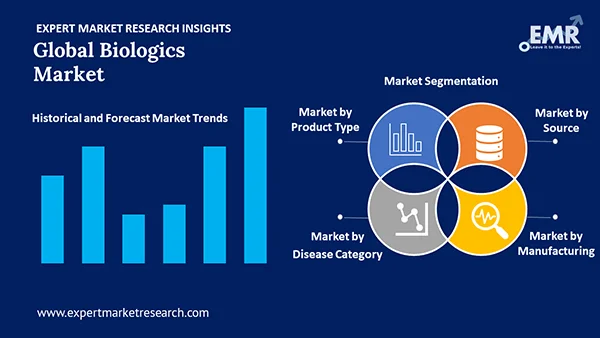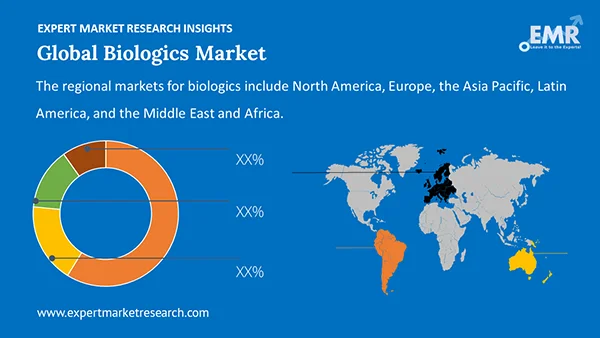Reports
Sale

Global Biologics Market Size, Share, Trends, Growth, Report: By Source: Microbial, Mammalian; By Product: Monoclonal Antibodies, Vaccines, Recombinant Proteins, Antisense, RNAi & Molecular Therapy, Cell Based Therapies, Tissue Engineering, Others; By Indication; By Distribution Channel; Regional Analysis; Supplier Landscape; 2024-2032
Global Biologics Market Outlook
The global biologics market size was valued at USD 381.9 billion in 2023, driven by the growing demand for biologics therapeutics to treat chronic diseases across the globe. The market is expected to grow at a CAGR of 7.2% during the forecast period of 2024-2032, with the values likely to rise from USD 416.3 billion in 2024 to USD 727.3 billion by 2032.

Read more about this report - REQUEST FREE SAMPLE COPY IN PDF
Global Biologics Market Overview
Biologics include products obtained from living organisms or their certain components. Biologic drugs can be derived from humans, animals, or microorganisms by utilizing biotechnological techniques. It includes a diverse range of therapeutic products such as vaccines, blood components, tissues, genes, and recombinant proteins. Biologics are considered the most advanced therapies, used for treating diseases such as rheumatoid arthritis, and Crohn’s disease, among other autoimmune disorders.
The biologics market demand is driven by the prevalence of chronic diseases, necessitating the need for improved diagnostics and treatment drugs. There is an increased impetus for research and development activities to enhance the productivity of biologics products. Biologics have shown promising results in the treatment of chronic diseases such as rheumatoid arthritis (RA), which poses a lifetime risk of 4% in women and 3% in men. Studies have revealed that biologics can improve joint function in patients with RA, along with reducing drug dependency. Thus, it opens a wide avenue for effective therapeutics, that can fuel the growth of the biologics market.
Rising Investments to Fuel Biologics Market Growth
The increased investment and funding to accelerate the expansion of biologics research and manufacturing facilities is driving the market growth. In October 2023, Syngene International, Biocon's global innovation-focused subsidiary, announced its annual investment plan of USD 100 million in biologics, research, and small molecules. The company also revealed that their biologics division is rapidly expanding and delivering positive results. With the latest investment strategy, the company plans to enhance their manufacturing capabilities along with capacity expansion to align with the rising demand of the biologics market.
Technological Advancements to Develop High-Quality Biologics
Biologics represent cutting-edge medicines with the potential to treat medical conditions with no other treatment available. Biopharmaceutical companies are working towards developing standards and reference materials to improve quality assessment in the biological therapies space, expected to bolster the biologics market share in the forecast period.
In October 2023, American Type Culture Collection (ATCC) and United States Pharmacopeia (USP), two United States-based nonprofit premier global biological materials management and standard organizations, launched a set of 6 products to mitigate the risk involved in the manufacturing of biologics such as vaccines. The joint products marketed by the companies contain pure genomic DNA that can advance quality control of various biotherapeutic products by measuring residual host cell DNA. The development of such reference materials will ensure the quality and safety of biologics and will subsequently help in the market growth.
Strategic Collaborations to Boost Biologics Market Size
To meet the rising demand for biologics, biopharmaceutical companies are entering into strategic collaborations and partnerships to achieve substantial market share. In October 2023, Salipro Biotech AB (a Sweden-based biotechnology company) and Icosagen (a contract research, development, and manufacturing organization headquartered in Estonia) announced their collaboration to accelerate drug discovery programs. The alliance is primarily focused on monoclonal antibody discovery and characterization against challenging membrane proteins. By leveraging the shared resources and expertise, the companies plan to establish a solid foundation for biologic drug development.

Read more about this report - REQUEST FREE SAMPLE COPY IN PDF
Global Biologics Market Segmentation
Market Breakup by Source
- Microbial
- Mammalian
Market Breakup by Product
- Monoclonal Antibodies
- Human mABs
- Humanized mABs
- Chimeric mABs
- Murine mABs
- Vaccines
- Recombinant Proteins
- Antisense, RNAi & molecular therapy
- Cell Based Therapies
- Stem Cell Therapy
- CAR-T Cell Therapy
- Tissue Engineering
- Others
Market Breakup by Indication
- Oncology
- Immunological Disorders
- Cardiovascular Disorders
- Hematological Disorders
- Others
Market Breakup by Distribution Channel
- Hospital Pharmacies
- Retail Pharmacies
- Online Pharmacies
Market Breakup by Region
- North America
- Europe
- Asia Pacific
- Latin America
- Middle East and Africa

Read more about this report - REQUEST FREE SAMPLE COPY IN PDF
Global Biologics Market Regional Analysis
North America is the leading market in the biologics sector, which can be attributed to the rising prevalence of chronic diseases and growing awareness around advanced technologies such as gene therapy and RNAi therapy. In addition, the presence of leading biopharmaceutical companies in the region working towards improving the quality and efficiency of biologics is also driving the market growth.
The biologics market share is rapidly growing in Europe, owing to its advanced healthcare system and the increasing demand for personalized medicines. Several biopharmaceutical companies in the region are expanding their product portfolios by entering strategic collaborations which is boosting the market growth. In December 2023, AstraZeneca plc, a multinational pharmaceutical and biotechnology company with its headquarters in England, announced its collaboration with an artificial intelligence biologics firm, Absci, by signing an agreement for up to USD 247 million to develop an antibody against cancer.
Global Biologics Market: Competitor Landscape
In July 2023, a Danish-based medical devices company, Coloplast, announced its acquisition of Kerecis, a wound care company in Iceland, for a deal worth USD 1.3 billion. The acquisition is aimed at expanding the company’s wound care portfolio in the biologics sector. Coloplast plans to leverage Kerecis's advanced technology to treat burns and wounds by using fish skin, which is shown to aid wound healing by facilitating cellular ingrowth. This indicates a market trend of rising mergers and acquisitions which is expected to increase the biologics market size in the forecast period.
The key features of the market report include patent analysis, grants analysis, funding and investment analysis, partnerships, and collaborations analysis by the leading key players. The major companies in the market are as follows:
- AbbVie Inc.
- Amgen Inc.
- Lilly
- F. Hoffmann-La Roche AG
- Samsung Biologics
- Sanofi
- Pfizer Inc.
- Merck & Co., Inc.
- Novo Nordisk A/S
- Johnson & Johnson Services, Inc.
- Bristol-Myers Squibb Company
- Celltrion Inc.
- BD
- Bayer AG
- AstraZeneca
Kindly note that this only represents a partial list of companies, and the complete list has been provided in the report.
Key Highlights of the Report
| REPORT FEATURES | DETAILS |
| Base Year | 2023 |
| Historical Period | 2017-2023 |
| Forecast Period | 2024-2032 |
| Scope of the Report |
Historical and Forecast Trends, Industry Drivers and Constraints, Historical and Forecast Market Analysis by Segment:
|
| Breakup by Source |
|
| Breakup by Product |
|
| Breakup by Indication |
|
| Breakup by Distribution Channel |
|
| Breakup by Region |
|
| Market Dynamics |
|
| Competitive Landscape |
|
| Companies Covered |
|
*At Expert Market Research, we strive to always give you current and accurate information. The numbers depicted in the description are indicative and may differ from the actual numbers in the final EMR report.
1 Preface
1.1 Objectives of the Study
1.2 Key Assumptions
1.3 Report Coverage – Key Segmentation and Scope
1.4 Research Methodology
2 Executive Summary
3 Global Biologics Market Overview
3.1 Global Biologics Market Historical Value (2017-2023)
3.2 Global Biologics Market Forecast Value (2024-2032)
4 Global Biologics Market Landscape*
4.1 Global Biologics Developers Landscape
4.1.1 Analysis by Year of Establishment
4.1.2 Analysis by Company Size
4.1.3 Analysis by Region
4.2 Global Biologics Product Landscape
4.2.1 Analysis by Source
4.2.2 Analysis by Product
5 Global Biologics Market Dynamics
5.1 Market Drivers and Constraints
5.2 SWOT Analysis
5.2.1 Strengths
5.2.2 Weaknesses
5.2.3 Opportunities
5.2.4 Threats
5.3 Porter’s Five Forces Model
5.3.1 Bargaining Power of Suppliers
5.3.2 Bargaining Power of Buyers
5.3.3 Threat of New Entrants
5.3.4 Threat of Substitutes
5.3.5 Degree of Rivalry
5.4 Key Demand Indicators
5.5 Key Price Indicators
5.6 Industry Events, Initiatives, and Trends
5.7 Value Chain Analysis
6 Global Biologics Market Segmentation (2017-2032)
6.1 Global Biologics Market (2017-2032) by Source
6.1.1 Market Overview
6.1.2 Microbial
6.1.3 Mammalian
6.2 Global Biologics Market (2017-2032) by Product
6.2.1 Market Overview
6.2.2 Monoclonal Antibodies
6.2.2.1 Human mABs
6.2.2.2 Humanized mABs
6.2.2.3 Chimeric mABs
6.2.2.4 Murine mABs
6.2.3 Vaccines
6.2.4 Recombinant Proteins
6.2.5 Antisense, RNAi & molecular therapy
6.2.6 Cell Based Therapies
6.2.6.1 Stem Cell Therapy
6.2.6.2 CAR-T Cell Therapy
6.2.7 Tissue Engineering
6.2.8 Others
6.3 Global Biologics Market (2017-2032) by Indication
6.3.1 Market Overview
6.3.2 Oncology
6.3.3 Immunological Disorders
6.3.4 Cardiovascular Disorders
6.3.5 Hematological Disorders
6.3.6 Others
6.4 Global Biologics Market (2017-2032) by Distribution Channel
6.4.1 Hospital Pharmacies
6.4.2 Retail Pharmacies
6.4.3 Online Pharmacies
6.5 Global Biologics Market (2017-2032) by Region
6.5.1 Market Overview
6.5.2 North America
6.5.3 Europe
6.5.4 Asia Pacific
6.5.5 Latin America
6.5.6 Middle East and Africa
7 North America Biologics Market (2017-2032)
7.1 North America Biologics Market (2017-2032) by Source
7.1.1 Market Overview
7.1.2 Microbial
7.1.3 Mammalian
7.2 North America Biologics Market (2017-2032) by Product
7.2.1 Market Overview
7.2.2 Monoclonal Antibodies
7.2.2.1 Human Monoclonal Antibodies
7.2.2.2 Humanized Monoclonal Antibodies
7.2.2.3 Chimeric Monoclonal Antibodies
7.2.2.4 Murine Monoclonal Antibodies
7.2.3 Vaccines
7.2.4 Recombinant Proteins
7.2.5 Antisense, RNAi & molecular therapy
7.2.6 Cell Based Therapies
7.2.6.1 Stem Cell Therapy
7.2.6.2 CAR-T Cell Therapy
7.2.7 Tissue Engineering
7.2.8 Others
7.3 North America Biologics Market (2017-2032) by Country
7.3.1 United States of America
7.3.2 Canada
8 Europe Biologics Market (2017-2032)
8.1 Europe Biologics Market (2017-2032) by Source
8.1.1 Market Overview
8.1.2 Microbial
8.1.3 Mammalian
8.2 Europe Biologics Market (2017-2032) by Product
8.2.1 Market Overview
8.2.2 Monoclonal Antibodies
8.2.2.1 Human mABs
8.2.2.2 Humanized mABs
8.2.2.3 Chimeric mABs
8.2.2.4 Murine mABs
8.2.3 Vaccines
8.2.4 Recombinant Proteins
8.2.5 Antisense, RNAi & molecular therapy
8.2.6 Cell Based Therapies
8.2.6.1 Stem Cell Therapy
8.2.6.2 CAR-T Cell Therapy
8.2.7 Tissue Engineering
8.2.8 Others
8.3 Europe Biologics Market (2017-2032) by Country
8.3.1 United Kingdom
8.3.2 Germany
8.3.3 France
8.3.4 Italy
8.3.5 Others
9 Asia Pacific Biologics Market (2017-2032)
9.1 Asia Pacific Biologics Market (2017-2032) by Source
9.1.1 Market Overview
9.1.2 Microbial
9.1.3 Mammalian
9.2 Asia Pacific Biologics Market (2017-2032) by Product
9.2.1 Market Overview
9.2.2 Monoclonal Antibodies
9.2.2.1 Human mABs
9.2.2.2 Humanized mABs
9.2.2.3 Chimeric mABs
9.2.2.4 Murine mABs
9.2.3 Vaccines
9.2.4 Recombinant Proteins
9.2.5 Antisense, RNAi & molecular therapy
9.2.6 Cell Based Therapies
9.2.6.1 Stem Cell Therapy
9.2.6.2 CAR-T Cell Therapy
9.2.7 Tissue Engineering
9.2.8 Others
9.3 Asia Pacific Biologics Market (2017-2032) by Country
9.3.1 China
9.3.2 Japan
9.3.3 India
9.3.4 Australia
9.3.5 ASEAN
9.3.6 Others
10 Latin America Biologics Market (2017-2032)
10.1 Latin America Biologics Market (2017-2032) by Source
10.1.1 Market Overview
10.1.2 Microbial
10.1.3 Mammalian
10.2 Latin America Biologics Market (2017-2032) by Product
10.2.1 Market Overview
10.2.2 Monoclonal Antibodies
10.2.2.1 Human mABs
10.2.2.2 Humanized mABs
10.2.2.3 Chimeric mABs
10.2.2.4 Murine mABs
10.2.3 Vaccines
10.2.4 Recombinant Proteins
10.2.5 Antisense, RNAi & molecular therapy
10.2.6 Cell Based Therapies
10.2.6.1 Stem Cell Therapy
10.2.6.2 CAR-T Cell Therapy
10.2.7 Tissue Engineering
10.2.8 Others
10.3 Latin America Biologics Market (2017-2032) by Country
10.3.1 Brazil
10.3.2 Argentina
10.3.3 Mexico
10.3.4 Others
11 Middle East and Africa Biologics Market (2017-2032)
11.1 Middle East and Africa Biologics Market (2017-2032) by Source
11.1.1 Market Overview
11.1.2 Microbial
11.1.3 Mammalian
11.2 Middle East and Africa Biologics Market (2017-2032) by Product
11.2.1 Market Overview
11.2.2 Monoclonal Antibodies
11.2.2.1 Human mABs
11.2.2.2 Humanized mABs
11.2.2.3 Chimeric mABs
11.2.2.4 Murine mABs
11.2.3 Vaccines
11.2.4 Recombinant Proteins
11.2.5 Antisense, RNAi & molecular therapy
11.2.6 Cell Based Therapies
11.2.6.1 Stem Cell Therapy
11.2.6.2 CAR-T Cell Therapy
11.2.7 Tissue Engineering
11.2.8 Others
11.3 Middle East and Africa Biologics Market (2017-2032) by Country
11.3.1 Saudi Arabia
11.3.2 United Arab Emirates
11.3.3 Nigeria
11.3.4 South Africa
11.3.5 Others
12 Regulatory Framework
12.1 Regulatory Overview
12.1.1 US FDA
12.1.2 EU EMA
12.1.3 INDIA CDSCO
12.1.4 JAPAN PMDA
12.1.5 Others
13 Patent Analysis
13.1 Analysis by Type of Patent
13.2 Analysis by Publication Year
13.3 Analysis by Issuing Authority
13.4 Analysis by Patent Age
13.5 Analysis by CPC Analysis
13.6 Analysis by Patent Valuation
13.7 Analysis by Key Players
14 Grants Analysis
14.1 Analysis by Year
14.2 Analysis by Amount Awarded
14.3 Analysis by Issuing Authority
14.4 Analysis by Grant Application
14.5 Analysis by Funding Institute
14.6 Analysis by NIH Departments
14.7 Analysis by Recipient Organization
15 Funding and Investment Analysis
15.1 Analysis by Funding Instances
15.2 Analysis by Type of Funding
15.3 Analysis by Funding Amount
15.4 Analysis by Leading Players
15.5 Analysis by Leading Investors
15.6 Analysis by Geography
16 Partnership and Collaborations Analysis
16.1 Analysis by Partnership Instances
16.2 Analysis by Type of Partnership
16.3 Analysis by Leading Players
16.4 Analysis by Geography
17 Supplier Landscape (Customisable)
17.1 AbbVie Inc.
17.1.1 Company Overview
17.1.2 Product Portfolio
17.1.3 Demographic Reach and Achievements
17.1.4 Mergers and Acquisitions
17.1.5 Certifications
17.2 Amgen Inc.
17.2.1 Company Overview
17.2.2 Product Portfolio
17.2.3 Demographic Reach and Achievements
17.2.4 Mergers and Acquisitions
17.2.5 Certifications
17.3 Lilly
17.3.1 Company Overview
17.3.2 Product Portfolio
17.3.3 Demographic Reach and Achievements
17.3.4 Mergers and Acquisitions
17.3.5 Certifications
17.4 F. Hoffmann-La Roche AG
17.4.1 Company Overview
17.4.2 Product Portfolio
17.4.3 Demographic Reach and Achievements
17.4.4 Mergers and Acquisitions
17.4.5 Certifications
17.5 Samsung Biologics
17.5.1 Company Overview
17.5.2 Product Portfolio
17.5.3 Demographic Reach and Achievements
17.5.4 Mergers and Acquisitions
17.5.5 Certifications
17.6 Sanofi
17.6.1 Company Overview
17.6.2 Product Portfolio
17.6.3 Demographic Reach and Achievements
17.6.4 Mergers and Acquisitions
17.6.5 Certifications
17.7 Pfizer Inc.
17.7.1 Company Overview
17.7.2 Product Portfolio
17.7.3 Demographic Reach and Achievements
17.7.4 Mergers and Acquisitions
17.7.5 Certifications
17.8 Merck & Co., Inc.
17.8.1 Company Overview
17.8.2 Product Portfolio
17.8.3 Demographic Reach and Achievements
17.8.4 Mergers and Acquisitions
17.8.5 Certifications
17.9 Novo Nordisk A/S
17.9.1 Company Overview
17.9.2 Product Portfolio
17.9.3 Demographic Reach and Achievements
17.9.4 Mergers and Acquisitions
17.9.5 Certifications
17.10 Johnson & Johnson Services, Inc.
17.10.1 Company Overview
17.10.2 Product Portfolio
17.10.3 Demographic Reach and Achievements
17.10.4 Mergers and Acquisitions
17.10.5 Certifications
17.11 Bristol-Myers Squibb Company
17.11.1 Company Overview
17.11.2 Product Portfolio
17.11.3 Demographic Reach and Achievements
17.11.4 Mergers and Acquisitions
17.11.5 Certifications
17.12 Celltrion Inc.
17.12.1 Company Overview
17.12.2 Product Portfolio
17.12.3 Demographic Reach and Achievements
17.12.4 Mergers and Acquisitions
17.12.5 Certifications
17.13 BD
17.13.1 Company Overview
17.13.2 Product Portfolio
17.13.3 Demographic Reach and Achievements
17.13.4 Mergers and Acquisitions
17.13.5 Certifications
17.14 Bayer AG
17.14.1 Company Overview
17.14.2 Product Portfolio
17.14.3 Demographic Reach and Achievements
17.14.4 Mergers and Acquisitions
17.14.5 Certifications
17.15 AstraZeneca
17.15.1 Company Overview
17.15.2 Product Portfolio
17.15.3 Demographic Reach and Achievements
17.15.4 Mergers and Acquisitions
17.15.5 Certifications
List not exhaustive
18 Global Biologics Market - Distribution Model (Additional Insight)
18.1 Overview
18.2 Potential Distributors
18.3 Key Parameters for Distribution Partner Assessment
19 Key Opinion Leaders (KOL) Insights (Additional Insight)
20 Company Competitiveness Analysis (Additional Insight)
20.1 Very Small Companies
20.2 Small Companies
20.3 Mid-Sized Companies
20.4 Large Companies
20.5 Very Large Companies
21 Payment Methods (Additional Insight)
21.1 Government Funded
21.2 Private Insurance
21.3 Out-of-Pocket
*Additional insights provided are customisable as per client requirements.
* The coverage of the Market Landscape section depends on the data availability and may cover a minimum of 80% of the total market. The EMR team strives to make this section as comprehensive as possible.
The market attained a value of about USD 381.9 billion in 2023 driven by the growing demand for biologics therapeutics to treat chronic diseases across the globe.
The market is anticipated to grow at a CAGR of 7.2% during the forecast period of 2024-2032, likely to reach a market value of USD 727.3 billion by 2032.
The growing prevalence of chronic conditions, efforts to improve the productivity of biologics products, and the robust growth of the healthcare sector are some of the factors contributing to the increasing biologics market demand.
The surge in mergers and acquisitions activities is one of the major trends driving the biologics market. In July 2023, a Danish-based medical devices company, Coloplast, announced its acquisition of Kerecis for a deal worth USD 1.3 billion to expand its wound care portfolio in the biologics sector.
The market is divided into microbial, and mammalian based on the source type.
The market is divided into oncology, immunological disorders, cardiovascular disorders, and hematological disorders, among others.
The products are broadly segmented into monoclonal antibodies, vaccines, recombinant proteins, antisense, RNAi & molecular therapy, cell-based therapies, and tissue engineering, among others. Monoclonal antibodies are further divided tonto human mABs, humanized mABs, chimeric mABs, and murine mABs, which cell-based therapies include stem cell therapy and CAR-T cell therapy.
Major distribution channels in the market include hospital pharmacies, retail pharmacies, and online pharmacies.
The major regions of the market include North America, Europe, Asia Pacific, Latin America, Middle East, and Africa.
Key players involved in the market are AbbVie Inc., Amgen Inc., Lilly, F. Hoffmann-La Roche AG, Samsung Biologics, Sanofi, Pfizer Inc., Merck & Co., Inc., Novo Nordisk A/S, Johnson & Johnson Services, Inc., Bristol-Myers Squibb Company, Celltrion Inc., BD, Bayer AG, and AstraZeneca.
Mini Report
-
Selected Sections, One User
-
Printing Not Allowed
-
Email Delivery in PDF
-
Free Limited Customisation -
Post Sales Analyst Support -
50% Discount on Next Update
Single User License
-
All Sections, One User
-
One Print Allowed
-
Email Delivery in PDF
-
Free Limited Customisation -
Post Sales Analyst Support -
50% Discount on Next Update

Five User License
-
All Sections, Five Users
-
Five Prints Allowed
-
Email Delivery in PDF
-
Free Limited Customisation
-
Post Sales Analyst Support
-
50% Discount on Next Update
Corporate License
-
All Sections, Unlimited Users
-
Unlimited Prints Allowed
-
Email Delivery in PDF + Excel
-
Free Limited Customisation
-
Post Sales Analyst Support
-
50% Discount on Next Update
Any Question? Speak With An Analyst
View A Sample
Did You Miss Anything, Ask Now
Right People
We are technically excellent, strategic, practical, experienced and efficient; our analysts are hand-picked based on having the right attributes to work successfully and execute projects based on your expectations.
Right Methodology
We leverage our cutting-edge technology, our access to trusted databases, and our knowledge of the current models used in the market to deliver you research solutions that are tailored to your needs and put you ahead of the curve.
Right Price
We deliver in-depth and superior quality research in prices that are reasonable, unmatchable, and shows our understanding of your resource structure. We, additionally, offer attractive discounts on our upcoming reports.
Right Support
Our team of expert analysts are at your beck and call to deliver you optimum results that are customised to meet your precise needs within the specified timeframe and help you form a better understanding of the industry.


